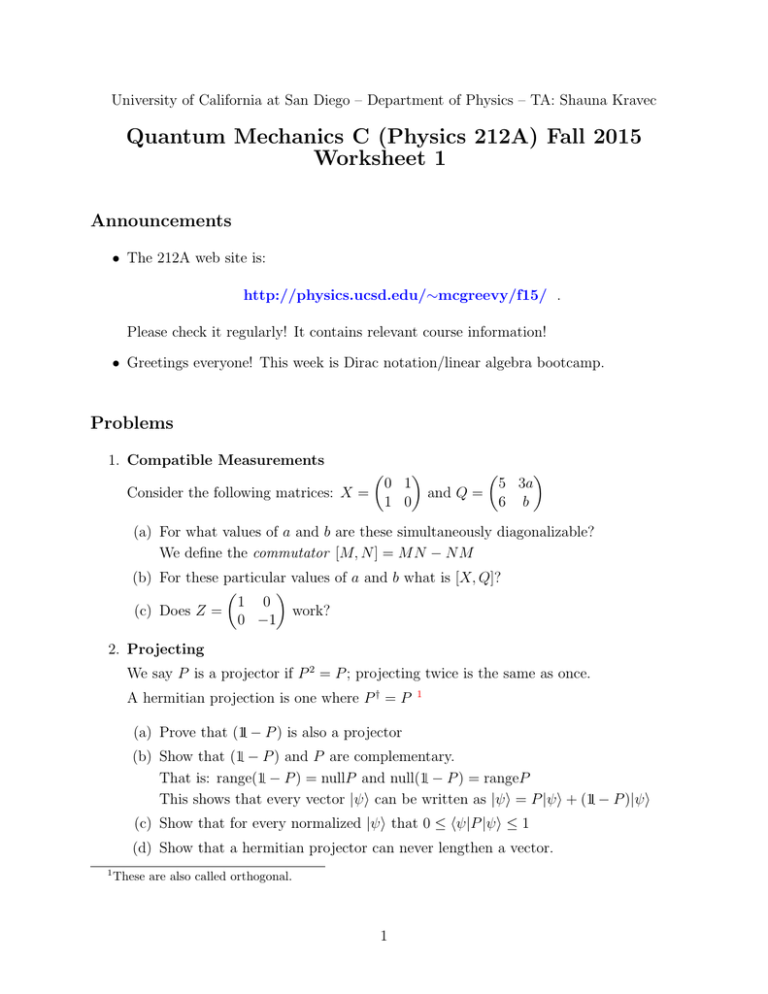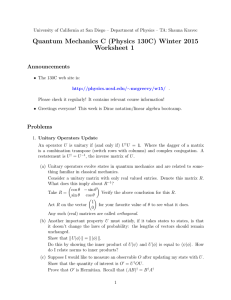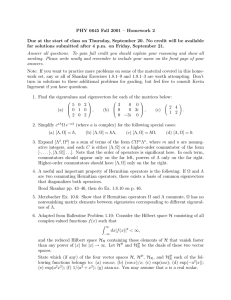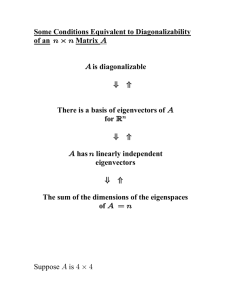Quantum Mechanics C (Physics 212A) Fall 2015 Worksheet 1 Announcements
advertisement

University of California at San Diego – Department of Physics – TA: Shauna Kravec
Quantum Mechanics C (Physics 212A) Fall 2015
Worksheet 1
Announcements
• The 212A web site is:
http://physics.ucsd.edu/∼mcgreevy/f15/ .
Please check it regularly! It contains relevant course information!
• Greetings everyone! This week is Dirac notation/linear algebra bootcamp.
Problems
1. Compatible Measurements
Consider the following matrices: X =
0 1
1 0
5 3a
and Q =
6 b
(a) For what values of a and b are these simultaneously diagonalizable?
We define the commutator [M, N ] = M N − N M
(b) For these particular values of a and b what is [X, Q]?
1 0
(c) Does Z =
work?
0 −1
2. Projecting
We say P is a projector if P 2 = P ; projecting twice is the same as once.
A hermitian projection is one where P † = P
1
(a) Prove that (1 − P ) is also a projector
(b) Show that (1 − P ) and P are complementary.
That is: range(1 − P ) = nullP and null(1 − P ) = rangeP
This shows that every vector |ψi can be written as |ψi = P |ψi + (1 − P )|ψi
(c) Show that for every normalized |ψi that 0 ≤ hψ|P |ψi ≤ 1
(d) Show that a hermitian projector can never lengthen a vector.
1
These are also called orthogonal.
1
3. Represent
Suppose the vectors {|ai, |bi, |ci} form an orthonormal basis for H where some operator
K̂ lives. Suppose we know also that these vectors are eigenvectors of K̂:
K̂|ai = 5|ai K̂|bi = −12|bi K̂|ci = 2i|ci
(1)
(a) Write the matrix K̂ using Dirac notation. Hint: K̂ = a |aiha| + b |bihb| + c |cihc|
(b) Consider |ψi = √12 (2|ai + 5i|ci) and compute hψ|K̂|ψi .
Do this using Dirac notation and regular matrix multiplication.
4. Gone with a Trace
Recall the trace of an operator Tr [A] =
P
m hm|A|mi
for the some basis set {|mi}
Prove that this definition is independent of basis.
Prove the cycle property: Tr [ABC] = Tr [BCA] = Tr [CAB]
Note that this implies if A is diagonalizable with eigenvalues λi that Tr [A] =
P
i
λi
5. A Very Useful Trick
Consider an operator A. Show the following identity
det eA = eTr
[A]
(2)
Hint: Recall that the determinant is the product of eigenvalues
6. Another Useful Trick
Recall that for generic operators A and B that eA eB 6= eA+B but rather
1
Z(A, B) ≡ log(eA eB ) = A + B + [A, B] + · · ·
(3)
2
where the · · · are terms involving commutators of commutators. Ick. This is known
as the BCH expansion. Note the possibility to simplify.
One formal expression for (3) is
Z
Z(A, B) = A + B +
1
0
∞
X
(1 − eLA etLB )n−1 (eLA − 1)
dt
[A, B]
n(n + 1)
LA
n=1
(4)
where LX Y ≡ [X, Y ]
Consider [A, B] = uA + vB + c1.
(a) Show that LA [A, B] = v[A, B] and LB [A, B] = −u[A, B]
(b) Simplify (4) using the above eigenvalue relations.
(c) Evaluate the integral/sum explicitly. Use
log(x)x
x−1
=1−
(1−x)n
n=1 n(n+1)
P∞
You should get Z(A, B) = A + B + f (u, v)[A, B] where
f (u, v) =
(u − v)eu+v − (ueu − vev )
uv(eu − ev )
2
(5)





